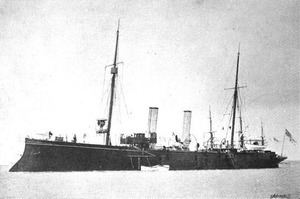Name SMS Blitz Commissioned 28 March 1883 Fate Scrapped, 1921 Construction started 1881 | Laid down 1881 Struck 8 March 1921 Launched 26 August 1882 | |
 | ||
Builder Friedrich Krupp Germaniawerft | ||
SMS Blitz was an aviso of the Imperial German Navy, the lead ship of her class. She had one sister ship, SMS Pfeil. Blitz was built at the Norddeutscher Schiffbau dockyard; she was laid down in 1881, was launched in August 1882, and was commissioned in March 1883. The ship's career was uneventful; she served as a flotilla leader for torpedo boats until 1900. In 1903, she became a fleet tender. She was briefly mobilized at the outbreak of World War I in August 1914, but she returned to fleet tender duties in 1915, where she remained for the duration of the conflict. She was stricken from the naval register in March 1921 and was broken up for scrap later that year.
Contents
Design
Blitz was 78.43 meters (257.3 ft) long overall and had a beam of 9.9 m (32 ft) and a maximum draft of 4.07 m (13.4 ft) forward. She displaced 1,486 metric tons (1,463 long tons; 1,638 short tons) at full combat load. Her propulsion system consisted of two horizontal 2-cylinder double expansion engines. Steam for the engines was provided by eight coal-fired locomotive boilers. The ship's propulsion system provided a top speed of 15.7 kn (29.1 km/h; 18.1 mph) and a range of approximately 2,440 nautical miles (4,520 km; 2,810 mi) at 9 kn (17 km/h; 10 mph). Blitz had a crew of 7 officers and 127 enlisted men.
As built, the ship was armed with one 12.5 cm (4.9 in) K L/23 gun placed in a pivot mount. The gun was supplied with 100 rounds of ammunition. The ship was also equipped with four 8.7 cm K L/23 guns in single mounts and one 35 cm (14 in) torpedo tube mounted in the bow. In 1891–1892, the ship was rearmed with six 8.8 cm SK L/30 guns in single mounts and three 35 cm torpedo tubes, one in the bow and one on each broadside, all submerged in the hull.
Service history
Blitz was laid down at the Norddeutscher Schiffbau in Kiel in 1881. She was launched on 26 August 1882 and commissioned into the German fleet on 28 March 1883. Blitz served as the flotilla leader for I Torpedo Boat Flotilla after her commissioning. In the 1885 summer maneuvers in August and September, she led her torpedo boats with an armored warship division composed of Bayern, Friedrich Carl, and Hansa, and an unarmored division that comprised three old sail corvettes and Pfeil. At the time, Alfred von Tirpitz, the future architect of the High Seas Fleet, commanded Blitz and the torpedo boat flotilla. Starting in March 1886, Tirpitz led the flotilla on training exercises that lasted until July. Thereafter, Blitz and her accompanying torpedo boats joined the annual fleet maneuvers as the III Division. In May, Blitz joined the Training Squadron as a torpedo boat leader during training exercises with the Maneuver Squadron in the Baltic.
In 1887, Blitz, again with Tirpitz aboard, led the torpedo boat flotilla to Britain to participate in the Cowes Regatta; the delegation was headed by Prince Heinrich. Then-prince Wilhelm—the future Kaiser Wilhelm II—was also present for the cruise, aboard Blitz. The flotilla was back in German waters for the annual August–September maneuvers, where it formed the IV Division. By 1888, Blitz had been transferred to the III Flotilla. In July, Blitz joined a squadron of ships to take the newly crowned Kaiser Wilhelm II for a tour of Baltic ports, which included a visit to Tsar Alexander III of Russia. During the August–September fleet maneuvers, she led the fourteen torpedo boats of the III Flotilla as part of a squadron defending Wilhelmshaven from a simulated hostile squadron. During the maneuvers, Blitz and the torpedo boats led a mock attack against the main fleet.
In the fleet maneuvers in late 1890, Blitz and her flotilla were the only German force, and Blitz was given the task of defending Germany's Baltic coast against a simulated Russian blockade. Blitz also took part in the 1891 and 1892 training exercises. During the 1894 maneuvers, which postulated a two-front war against France and Russia, Blitz remained in the Baltic to defend against the simulated Russian attack. She also participated in the summer 1897 exercises in the simulated hostile squadron, along with her sister Pfeil. In August–September 1900, she participated in the annual summer fleet maneuvers; during the exercises, she was assigned to the simulated German squadron, tasked with defending against a simulated enemy fleet in the North Sea. After the conclusion of the maneuvers, Blitz was withdrawn from active service. In 1903, she was used as a tender for the fleet.
In 1912, she was assigned as the tender for the new dreadnought battleships of the I Battle Squadron. While in the II Squadron, she wore a white identification band on her funnel, to distinguish her from her sister Pfeil, which wore a yellow identification stripe. At the outbreak of World War I in August 1914, she was mobilized as a coastal defense ship, though this duty lasted only until 1915. That year, she returned to her fleet tender duties; she served in this capacity for the remainder of the war. She was stricken from the naval register on 8 March 1921, and sold for 520,000 marks. She was broken up for scrap later that year in Wilhelmshaven.
